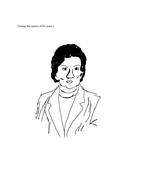Ayhan Ulubelen
| Ayhan Ulubelen | |
|---|---|
|
A student's drawing of Ulubelen | |
| Born |
August 20, 1931 Istanbul, Turkey |
| Residence | Instanbul Turkey |
| Citizenship | Turkey |
| Nationality | Turkish |
| Fields | Analytical Chemistry |
| Institutions | University of Istanbul |
| Alma mater | University of Istanbul |
| Known for | Testing plants from Turkey and each separate compound in the plants for medical needs |
Ayhan Ulubelen (born 1931) is an analytical chemist and member of the Turkish Academy of Sciences.[1] She has contributed to the isolation and testing of natural products from Turkish plants relevant to spontaneous abortion, cancer, HIV, and diabetes.
Life and career
Ulubelen was born August 20, 1931 in Istanbul, Turkey. Her father was an army officer, and her mother was a housewife. In high school, she saw a movie about Madame Curie and soon wanted to be a chemist.
She sought a position in chemical industry, but became analytical chemist at the Faculty of Pharmacy of Istanbul University, partly through her having passed the language examination.
Ulubelen received her degree in analytical chemistry at Istanbul University in 1956, followed by two years of postdoctoral research at the University of Minnesota and then by four years of cancer research at the University of Arizona. In 1976, she became a full professor at Istanbul University, while spending several months at each of: Japan (support by JSPS), Germany (support by DAAD), and the University of Texas at Austin (support by NATO).
Ulubelen has published more than 300 papers, and has authored two books and 12 chapters in international books; her work has received support from Fulbright, NIH, DAAD, JSPS, and NATO. She has mentored over 20 graduate students, of whom many have proceeded to prominent positions in academia, as well as pharmaceutical and chemical companies.
Research
Ulubelen's research focuses on isolation, structure determination, and pharmacological investigation of Turkish plants and compounds isolated from them, and especially on isolates from plants abundant in Turkey and mentioned in Turkish folklore and medicine. Her work with triterpenes and flavonoids was followed by work on diterpenoids, to find plant components that produce various medical effects including spontaneous abortion and wound healing.
During tests on mice, Ulubelen found an abortive factor developing cystic degeneration in the ovaries, but was unsure whether the effect was caused by the abortive agent or by some other compound. Ten compounds from the source plant were studied, including screening by a Faculty of Medicine group for toxic effects to the ovaries, livers, kidneys, and brain. At that time, Ulubelen said
"...we can't recommend that women should be using these plants as an abortive agent. We have so informed the pharmacist who sent them to us, and I'm sure she's passing this information on to the villagers."[2]
3-Benzoxepin does not occur naturally but is the skeletal moiety around which several natural products are built, including perilloxin (I) from Perilla frutescens (variant acuta)[3] and tenual (II) and tenucarb (III) from Asphodeline tenuior, which Ulubelen helped to isolate.[4]
Honors
Ulubelen’s honors include: Honorary Membership to the Chemical Society of Turkey (first award recipient, 1985), NATO Scientific Committee membership (selected from among ten NATO countries, 1986–1990), Science Award by the Scientific and Technological Research Council of Turkey (1991), full member (1994–2001) and honorary member of the Turkish Academy of Sciences (2001-), and the American Pharmaceutical Association Young Scientist awards (1962, 1963, 1964). She has served in the Chemrawn Committee of IUPAC as an associate and full member (2003–2009).[5]
References
- ↑ "An Independent Science Academy Founded in Turkey". Bilim Akademisi. 2011-08-27. Archived from the original on 2013-06-30. Retrieved 2013-07-09.
- ↑ Imperial College Press (2000). Hargittai, Candid Science. London: World Scientific Publishing Co. Pte. Ltd. pp. 114–121. ISBN 1-86094-151-6.
- ↑ Liu, J.-H.; Steigel, A.; Reininger, E.; Bauer, R. (2000). "Two new prenylated 3-benzoxepin derivatives as cyclooxygenase inhibitors from Perilla frutescens var. acuta". J. Nat. Prod. 63 (3): 403–405. doi:10.1021/np990362o.
- ↑ Ulubelen, A.; Tuzlaci, E.; Atilan, N. (1989). "Oxepine derivatives and anthraquinones from Asphodeline tenuior and A. taurica". Phytochem. 28 (2): 649–650. doi:10.1016/0031-9422(89)80076-7.
- ↑ "New Challenges in Natural Products Chemistry". Conference in honour of Prof. Dr. Ayhan Ulubelen. International Year of Chemistry 2011. Retrieved April 23, 2012.

